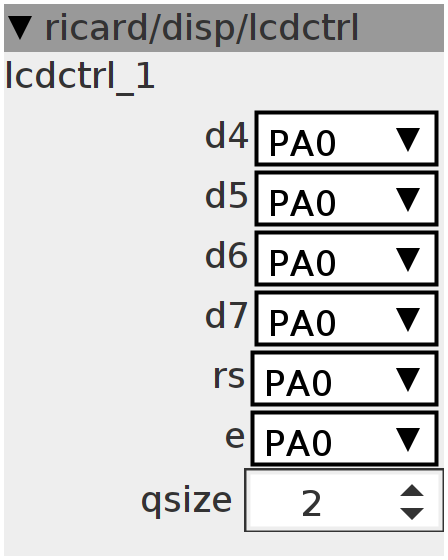lcdctrl
external lcd control
Inlets
None
Outlets
None
Attributes
combo LCD D4 pin
combo LCD D5 pin
combo LCD D6 pin
combo LCD D7 pin
combo LCD RS pin
combo LCD E pin
spinner Number of potential strings in print queue
int data;
int state; // 0..2 output high nybble, 3..5 output low, 6 ... delay for slow
// commands
int endstate; // final state, 6 for normal commands, 18 for slow
const char *initstr; // initialization string
__attribute__((noinline)) void print(const char *printstr) {
if (strings[wrindex])
return; // if queue full, drop string
strings[wrindex++] = printstr;
if (wrindex >= attr_qsize)
wrindex = 0;
}
const char *strings[attr_qsize]; // strings to output
int rdindex; // read index in circular string queue
int wrindex; // write index in circular string queuepalWritePad(attr_e, 0);
palSetPadMode(attr_d4, PAL_MODE_OUTPUT_PUSHPULL);
palSetPadMode(attr_d5, PAL_MODE_OUTPUT_PUSHPULL);
palSetPadMode(attr_d6, PAL_MODE_OUTPUT_PUSHPULL);
palSetPadMode(attr_d7, PAL_MODE_OUTPUT_PUSHPULL);
palSetPadMode(attr_rs, PAL_MODE_OUTPUT_PUSHPULL);
palSetPadMode(attr_e, PAL_MODE_OUTPUT_PUSHPULL);
state = 0;
// init: 0011, long wait - set 8 bit mode
// 0011, short wait - set 8 bit mode
// 0011, short wait - set 8 bit mode
// 0010, short wait - set 4 bit mode
// 0010 1000, short wait - 4 bit, function set:
// NFxx: N=1 => 2 lines, F=0 => 5x8 font
// 0000 1000, short wait - display off
// 0000 0001, long wait - display clear, set cursor and write addr home
// 0000 0110, short wait - entry mode set
// IS: I=1 => increment, S=0 => no shift
// 0000 1100, short wait - display on
// DCS: D=1 => display on, C=0 => no cursor, B=0 => no cursor blink
initstr = "\xf3\xb3\xb3\xb2\xb2\xb8\xb0\xb8\xb0\xf1\xb0\xb6\xb0\xbc"
"\x83"
"Axoloti on P6!";
strings[0] = initstr; // print initstring first
for (int i = 1; i < attr_qsize; i++) {
strings[i] = 0;
}
rdindex = 0; // start printing the init data
wrindex = 1; // next string to write// LCD Data: when bit 7 is clear, output ASCII data with RS=1
// with bit 7 is set, set cursor position: bit 6 = line (0/1),
// bit 5..0 = column (0..47, 0..39 used normally)
// when bits 5,4 are 1,1 (i.e. column would have ben 48 and above)
// bits 3,2,1,0 are output in 4 bit mode, and bit 6 indicates delay
// (0=> normal (100µs), 1=>4.1ms
// states 0,1,2 are for high nybble (output data,rs, then e=0,1,0)
// states 3,4,5 are for low nybble (output data (rs unchanged), then e=0,1,0)
// state >=6 are for long delay, just bump state until reached endstate
switch (state) {
int rs;
case 0:
if (!strings[rdindex])
break; // nothing to print
data = *strings[rdindex]++;
if (data == 0) { // NUL
strings[rdindex++] = 0; // mark as read
if (rdindex >= attr_qsize)
rdindex = 0;
break; // start printing next time around
}
// we assume e is low here
endstate = 4; // default is fast timing
rs = 1; // default register is data register
if (data & 0x80) { // control when bit 7 set
// else output ASCII to display data RAM
rs = 0; // command register
if ((data & 0x30) ==
0x30) { // special 4-bit
// else display write position (no further conditioning needed)
if (data & 0x40)
endstate = 16; // long delay: 4 states + 12*0.33ms (i.e. 4ms)
data <<= 4; // 4-bit data is in low nybble
state = 2; // next state pulses e high, then low, then we're done (modulo
// potential delay)
}
}
palWritePad(attr_rs, rs);
palWritePad(attr_d4, (data >> 4) & 1); // high nybble first in LCD 4 bit mode
palWritePad(attr_d5, (data >> 5) & 1);
palWritePad(attr_d6, (data >> 6) & 1);
palWritePad(attr_d7, (data >> 7) & 1);
palWritePad(attr_e, 1);
state++;
break;
case 2:
palWritePad(attr_d4,
(data >> 0) & 1); // low nybble after first in LCD 4 bit mode
palWritePad(attr_d5, (data >> 1) & 1);
palWritePad(attr_d6, (data >> 2) & 1);
palWritePad(attr_d7, (data >> 3) & 1);
palWritePad(attr_e, 1);
state++;
break;
case 1:
case 3:
palWritePad(attr_e, 0);
// fall through
default:
state++;
if (state >= endstate)
state = 0; // restart cycle when endstate reached
break;
}